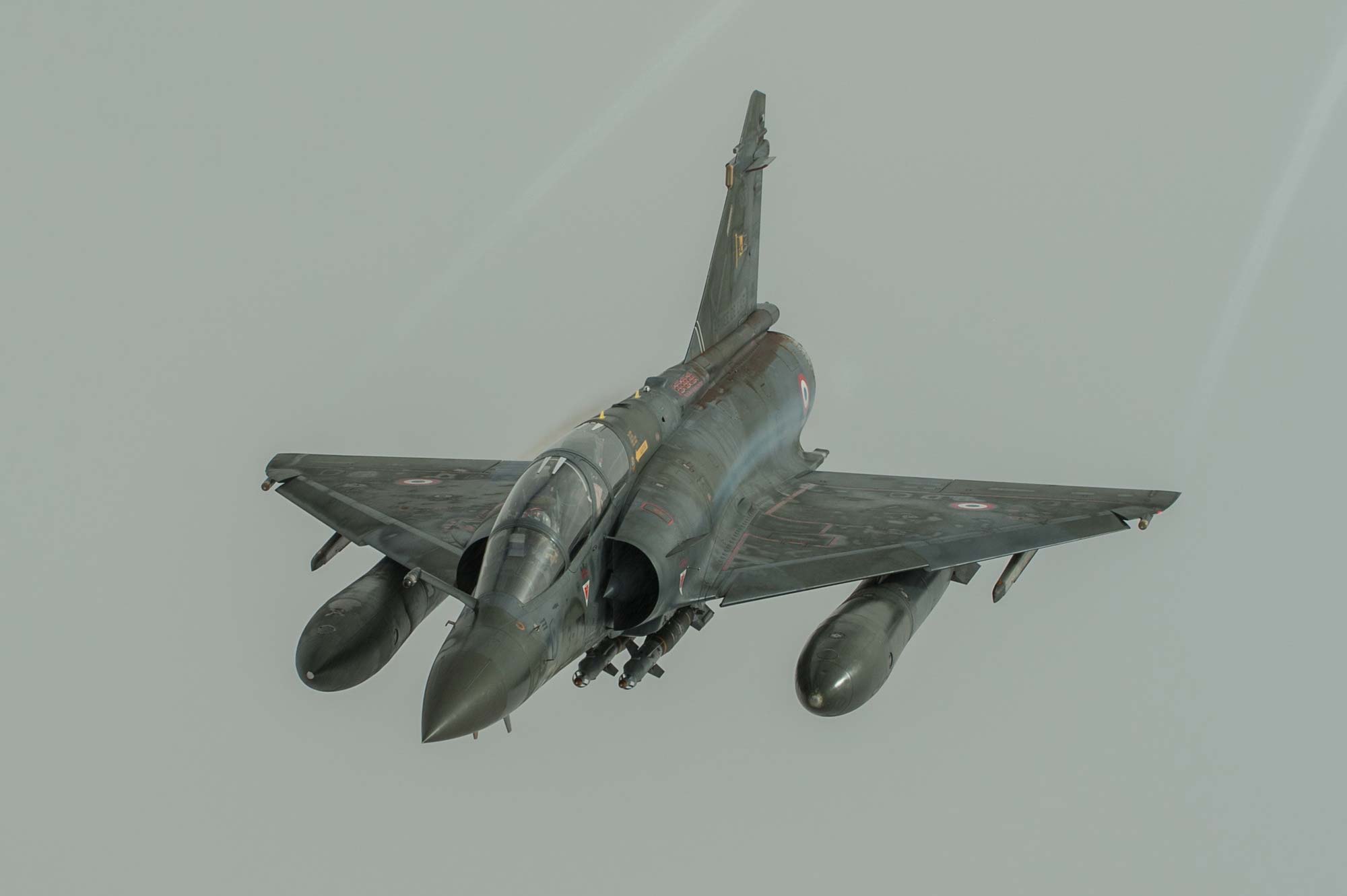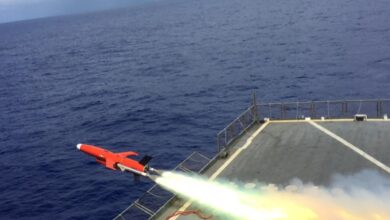French operations in Mali put 30 militants ‘out of action,’ as Barkhane builds Sahel Coalition coordination
Barkhane commando operations and airstrikes targeted Islamic State and al-Qaeda linked fighters in the tri-border area
French commando operations and airstrikes against groups linked to Islamic State and al-Qaeda in Mali put 30 militants “out of action,” the Armed Forces Ministry said.
The operations come as the France-led Operation Barkhane builds command coordination with local partner forces in sub-Saharan Africa’s Sahel region, setting up dedicated coordination mechanisms for the new Sahel Coalition in Niger’s capital Niamey and Chad’s capital N’Djamena.
Operations against ‘terrorists’ in Liptako-Gourma
Between February 6 and 7, forces deployed to Operation Barkhane conducted an “operation of opportunity” which “resulted in the neutralization of some 20 terrorists and the destruction of several vehicles,” the ministry said, in a Friday, February 7 release.
A Reaper drone, a Mirage 2000 fighter jet patrol, a Tigre attack helicopter and a Cougar transport helicopter “took part in two targeted strikes in an area where terrorist fighters had been spotted,” it said.
The action was carried out “in the west of the Gourma” region, in an area where the “katiba is rampant,” the release said. The ministry did not give further detail, but the likely target was Katiba Macina, one of the constituent groups of JNIM, which has pledged allegiance to al-Qaeda.
Also this week, Barkhane forces continued operations in the Liptako, where two separate commando actions led to a dozen terrorists being “put out of action” in areas where “Islamic State in the Greater Sahara” is active, the release said, without giving further details.
French military spokesperson Colonel Frederic Barbry said that 10 militants were “neutralized” in the actions, AFP reported.
The French Armed Forces groups those killed, injured or taken prisoner under the terms “neutralized” or taken “out of action,” according to AFP.
The French operations are the latest against Islamist militant groups in the region.
On January 23, the ministry said more than 30 “terrorists” were put out of action in operations in the Liptako-Gourma region. Commando operations targeted Katiba Macina fighters in Mali’s Mopti region, while Islamic State fighters were struck by a drone further east, near the border with Niger.
On January 16, the ministry said more than 1,000 troops from Mali, Burkina Faso, Niger, and Barkhane had taken part in a joint operation in the Liptako-Gourma region since early January and that 15 “terrorists” were put out of action. A week earlier, it said more than 50 “terrorists” were put out of action in a series of operations conducted in Mali between December 20 and January 5.

Joint FAMa-Barkhane actions south of Gao
Separately, Desert Battle Group 1 (GTD-1) “Steel” conducted an air-land maneuver on the western bank of the Niger River south of Gao, the latest in a series of joint operations in the area carried out in cooperation with the Malian Armed Forces (FAMa).
Some of the units deployed during the surprise action were transported by French Caiman and Danish Merlin helicopters, while others traveled by road.
“This mode of action allows the Barkhane force to act quickly and at distance, creating uncertainty among armed terrorist groups,” the ministry said in a February 6 release.
The joint forces were “tasked with the reconnaissance of a village and its surroundings” in southern Gao, where the population comes under occasional pressure from armed terrorist groups, the release said. FAMa troops “contributed to the sealing off of the area,” and their local knowledge and ability to quickly discern the presence of militants among the population was invaluable, the ministry said.
During the operation, “points of interest were searched and some resources were seized from caches, making it possible to direct future operations,” the release said.

Growing French presence in the Sahel
The French military presence in the Sahel began in 2013 with Operation Serval in Mali, and evolved in August 2014 into Operation Barkhane, which has a mandate for counter-terrorism operations across the region. The Barkhane force focuses activity in insurgent-hit Mali, Niger and Burkina Faso, working alongside local troops and other international operations, including the regional G5 Sahel Joint Force (FCG5S), which comprises troops from Burkina Faso, Mali, Niger, Chad and Mauritania, and MINUSMA, the U.N. stabiliization mission in Mali.
On February 2, Armed Forces Minister Florence Parly said that the number of French troops deployed to the Sahel would increase from 4,500 to 5,100. Around 220 of those troops have already deployed to the region, and the remaining 400 soldiers are expected to arrive by the end of February, according to Mali’s Communications Minister Yaya Sangare.
Around 30 heavy armored vehicles, 30 light armored vehicles and 20 logistics vehicles will also be deployed, the French ministry said, bringing the total number of military vehicles that have been sent to the Sahel to around 900, according to Philippe Chapleau.

Barkhane develops Sahel Coalition coordination mechanisms
France’s President Emmanuel Macron and the leaders of the G5 Sahel states injected new urgency into the counter-terrorism fight on January 13, announcing a new Coalition for the Sahel which will see increased coordination between French and local forces focused on the Mali-Burkina Faso-Niger tri-border zone and targeting Islamic State as a priority.
The new Sahel Coalition will see Barkhane and FCG5S forces operating under joint command.
“Barkhane is actively working to strengthen coordination” between its chain of command and partner forces operating in the tri-border zone, in particular the FCG5S, the French Armed Forces Ministry said in its weekly update published on February 6.
In coming days, a “dedicated structure” will be set up in Niger’s capital Niamey. The integration of liaison officers will “make it possible to coordinate and synchronise actions in the fields of intelligence, planning and conduct, and to improve response times in the event of an alert,” the ministry said.
In early February, Barkhane’s Joint Theater Command Post (PCIAT) in Chad’s capital N’Djamena integrated FCG5S liaison officers from Burkina Faso, Mali and Niger.
But the ministry stressed that the command coordination mechanism “is not a mechanism for merging chains of command.”
“While Barkhane is the only force capable of integrating external contributors to the Sahel, especially TF Takuba, the Joint Force is the only one that can ensure the command of units of the local forces,” it said.
In a move that looks set to enable joint operations in the tri-border area, Mali is to launch Operation Maliko, a new counter-terrorism operation that will take into account cross-border, regional and international cooperation, President Ibrahim Boubacar Keïta decreed last week. The PCIAT for Maliko’s East Theater is in Gao, which is also home to the only permanent base in Mali for Operation Barkhane.
G5 Sahel military chiefs of staff last week agreed to allow forces from one country to “support another force in another zone,” and to allow the forces from each state to pursue terrorist fighters up to 100 km into neighboring countries. Chad will soon deploy an additional battalion within the FCG5S in the tri-border zone.

France prepares to welcome Takuba partners to the Sahel
The “nature and missions” of the French reinforcements are likely to evolve over the next six months, in order to prepare in particular for the reception of European partners involved in the new international special operations Task Force Takuba, the French Armed Forces Ministry said in its weekly update published on February 6.
France has for months been trying to build support for Task Force Takuba, an international operation that will train, advise, assist and accompany local forces in their fight against Islamic State and al-Qaeda affiliates in the region.
The new French deployment will include around 50 special forces personnel who will form the nucleus of Takuba, Le Monde reported.
Takuba will declare initial military capability in the summer and will be fully operational by the autumn, Chief of the General Staff of the French Armed Forces General François Lecointre said on January 22.
France hopes that Takuba will comprise around 500 special forces personnel, according to Le Monde.
About a dozen European states have expressed interest in taking part, but concrete commitments to the new mission have been slow to materialize.
Estonia was the first French partner to confirm a deployment to Takuba. In November, a defense ministry spokesperson told The Defense Post that special forces will deploy to Mali in the second half of 2020. Belgium will send three staff officers to the mission, Belga reported in November, and the Czech Republic is planning to send 60 troops to join Takuba, the government said in late January.
On Wednesday, the Swedish Armed Forces said planning has begun for a possible deployment including helicopters, but both government and parliament must approve the plans.
Barkhane already has an international dimension, with European partners contributing troops and equipment. Estonia is to almost double the size of its force protection contingent this year, Denmark has deployed two Merlin helicopters, and three Chinook helicopters from the United Kingdom currently support the operation.
Islamist insurgents in the Sahel
The complex insurgency in the Sahel began in Mali in 2012, when a Tuareg separatist uprising was exploited by al-Qaeda-linked extremists who took key cities in the desert north. Former colonial power France began its Operation Serval military intervention the following year, driving the jihadists from the towns.
But the militant groups morphed into more nimble formations operating in rural areas, and the insurgency gradually spread to central and southern regions of Mali and then into Burkina Faso and Niger.
More than 4,000 people were reported killed in militant attacks in the three countries last year, according to the U.N., and Secretary-General Antonio Guterres has warned that the spiraling violence in the Sahel has spread to coastal states of West Africa.
Many armed groups including Islamic State are active in the Sahel region, but the majority of attacks are attributed to JNIM, which formed in March 2017 from a merger of several smaller groups. JNIM’s leadership has pledged allegiance to al-Qaeda leader Ayman al-Zawahiri.
Since May 2019, ISIS has attributed insurgent activities in the Sahel area to ISWAP, its West Africa Province affiliate that split from Boko Haram in 2016, rather than to Islamic State in the Greater Sahara. ISWAP’s main area of operations is the Lake Chad area of Nigeria, Niger, Chad and Cameroon.
Macron has said the Sahel Coalition would prioritize the fight against ISIS in the Mali-Burkina Faso-Niger tri-border area because it is the most dangerous.












